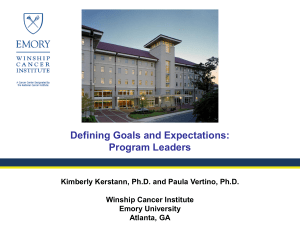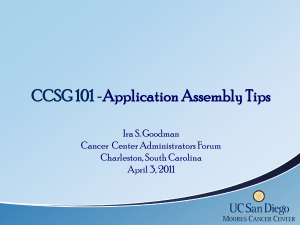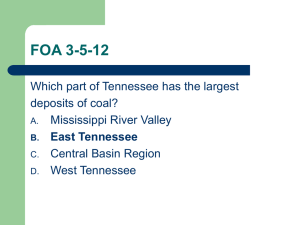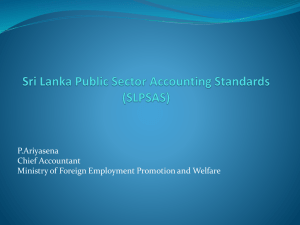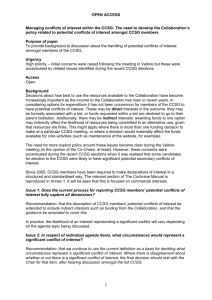Weiss - Moores Cancer Center
advertisement
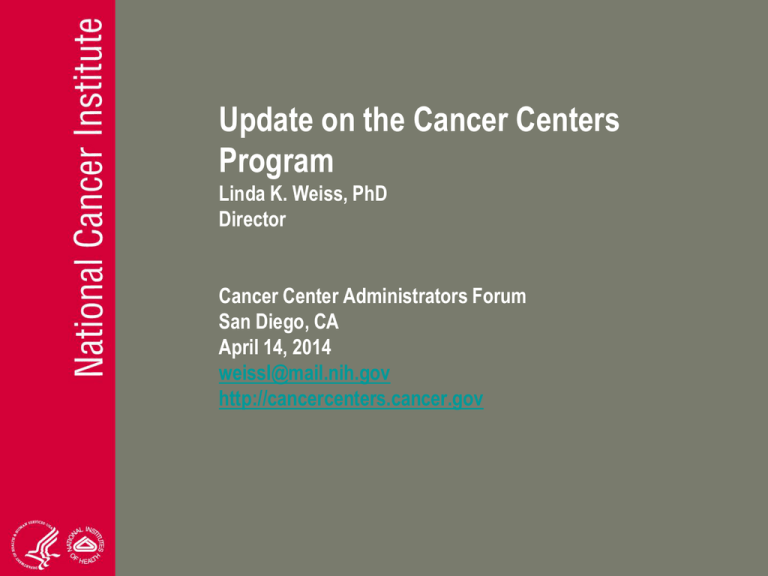
Update on the Cancer Centers Program Linda K. Weiss, PhD Director Cancer Center Administrators Forum San Diego, CA April 14, 2014 weissl@mail.nih.gov http://cancercenters.cancer.gov Overview • PAR 13-386: Where have all the Guidelines gone? • What should you consider as you prepare an application? • What changes are happening at site visits? • Are there other policies/issues to be aware of? • What is the status of the Cancer Centers Working Group? PAR 13-386: Where have all the Guidelines gone? • Electronic submission for P30 CCSG applications is now required • Plan ahead – there are more forms, a new arrangement of components, and new page limits • Rely on the FOA for application submission instructions, not the 2012 Guidelines – At this point, we do not plan to reissue CCSG Guidelines – All information pertinent to the application is in the FOA • “Peer Review Processes Relevant to the CCSG”, now a separate document, is on our website PAR 13-386: Where have all the Guidelines gone? (2) • Changes in Application Format and Organization – Application is standardized to component ‘types’ defined and approved by ASSIST: • • • • Overall Administration Core Project PAR 13-386: Where have all the Guidelines gone? (3) • Changes in Application Format and Organization (2) – General • Some component ‘types’ have multiple components within them • Most components request ‘Other Attachments’, e.g., tables, diagrams and other forms • Components may also have appendices • Name of the component should be in the first line of component text PAR 13-386: Where have all the Guidelines gone? (4) • Changes in Application Format and Organization (3) – Overall Component Type @ 30 page limit total to include: • Director’s Overview and Six Essential Characteristics (“Facilities” has now become “Physical Space”) • Official ‘Facilities’ form used to capture some information • All Data Tables now in “Other Attachments” – Administrative Core Component Type @ 12 page limit total to include: • Cancer Center Administration and Senior Leadership PAR 13-386: Where have all the Guidelines gone? (5) • Changes in Application Format and Organization (4) – Project Component Type @ 12 page limit each • Research Programs – Multiple “Other Attachments’” apply to this section – Some additional minor changes in wording re reporting of interventional trials, translation, value-added of shared resources » (See Outline of FOA Changes) PAR 13-386: Where have all the Guidelines gone? (6) • Changes in Application Format and Organization (5) – Core Component Type @ 12 page limit each to include: • Planning and Evaluation • Developmental Funds • Clinical Protocol and Data Management @ 12 page limit total to include: – Clinical Protocol and Data Management – Data and Safety Monitoring – Inclusion of Women, Minorities, and Children • Protocol Review and Monitoring System • Early Phase Clinical Research Support • Shared Resources @ 12 page limit each PAR 13-386: Where have all the Guidelines gone? (7) • Uploading the Application – First sort will be in the component ‘type’ order – Budget for ‘Overall’ will be summed total of components – Within component ‘types’, individual components will be uploaded in the order in which you put them into the system • For core components, preferred order is as in the sequence presented above • Consider uploading shared resources in ‘groupings’ – identify group in text • If you want groups of basic, clinical, and population science programs to appear together in the application, they should be uploaded together. PAR 13-386: Where have all the Guidelines gone? (8) • OCC will work with applicants to clarify where and how things are presented in the application • Technical questions on the electronic submission should be directed to ASSIST • Program and review staff are briefing reviewers on the format and limitations of the new electronic format What should you consider as you prepare an application? • General Considerations – Several components have been combined/shortened • Some of these components have specified attachments, which moves some data out of the narrative, but • You should carefully consider what is most important to relay in the application itself, vs. at the site visit, or not at all What should you consider as you prepare an application? (2) • Overall (2) – Budget instructions are now all in one specific section of the FOA – Only one set of biosketches is allowed – “Other Attachments” are limited to those specified in the FOA – they must be tables, graphs, lists, cannot include narrative – Appendices • • • • Cannot be used to avoid component page limits. Do not now include color photos Should be discussed with the PD prior to inclusion Are optional for review by peers What should you consider as you prepare an application? (3) • Overall (2) – LOI and RFI are now expected 60 days in advance of the application – Each section of the application asks: “Are human subjects involved?” • Centers should check yes in any component with research directly supported by the CCSG, e.g., Dev. or EPCRS funds • If you check yes in any individual component, you must check yes in the same question in the ‘Overall’ component – Applies to all clinical and comp centers but also to some basics – If you check yes, ASSIST will require attachments on inclusion of women, minorities, and children – You can attach a pdf. indicating ‘not applicable’ – Inclusion data are reported as an ‘Other Attachment’ in CPDM – Do not include planned enrollment tables What should you consider as you prepare an application? (4) • The Catchment Area – In Clinical Protocol and Data Management • Define the catchment area – should be population-based, straightforward and simple, have a solid rationale • Present a plan for assuring appropriate representation • “Other Attachments” now include – Summary information on the demographics of your defined catchment area – Tables in SF 424 format for accrual to interventional treatment, interventional non-treatment, and non-interventional studies (not planned enrollment) What should you consider as you prepare an application? (5) • The Catchment Area (2) – In Research Programs • Make catchment area issues evident in the write-up, as relevant • Focus on catchment area doesn’t have to be in – all Programs – but is expected in clinical and pop sci – all research projects within a Program • Is not about outreach or accrual of minorities and women • Not every sub-population has to be represented • Many ways to substantiate – In Senior Leadership • Focus on how senior leaders monitor and facilitate research – In Organizational Capabilities • Focus on whether the center is organized to apply its expertise and resources to research What should you consider as you prepare an application? (6) • Shared Resources – Document importance to the science in program writeups – what is the value added? – Include a separate narrative and budget for each – Group them any way you want – Primary source of information for reviewers will be the application – At site visit, focus on updates and changes since the submission – Tours of the clinical trials office will continue; other tours possible What should you consider as you prepare an application? (7) • Education and training of biomedical researchers and health care professionals ― Applicable to senior leadership – how the leaders work together to monitor, coordinate, integrate and assess the training efforts of the center ― Not a requirement of Research Programs ― Not just a list of training grants What should you consider as you prepare an application? (8) • Comprehensiveness ― Some criteria have changed • Depth and breadth of basic, clinical, and population science • Evidence of strong interdisciplinary science that bridges these areas • Service to the catchment area in terms of the research supported • Training and education that enables the scientific mission ― No longer a 2nd stage review focused on outreach ― Draft site visit report will have site visitors comments as before ― Sub-committee A (Parent Committee) will vote on comprehensiveness What changes are happening at site visits? • Time on site is a bit shorter • Although centers have greater scheduling flexibility: • • All programs are still being presented, though time allotted varies In general, centers are presenting the same components as before • Shared Resources are reviewed the night before the site visit ― Most centers continue to have poster sessions but they are not necessary ― Efficiency of shared resource groupings for review is still under evaluation ― Reviewers still expect to see minutes, strategic plan protocols, biosketches, etc. Are there other policies/issues to be aware of? • Delayed Onset Human Subjects Research – Delayed onset human subjects research policy applies to “awards that were submitted with the intent to conduct human subjects research during the period of support, but for which definitive plans could not be described in the application” (http://grants.nih.gov/grants/guide/notice-files/NOT-OD12-130.html) – For P30 CCSGs, it may be relevant to projects funded with Developmental or EPCRS funds – If you anticipate that you will be funding human subjects research projects, you should check ‘yes’ to human subjects on the appropriate ASSIST form Are there other policies/issues to be aware of? (2) • Delayed Onset Human Subjects Research (2) – If you check ‘yes’ to human subjects, an attachment on Protection of Human Subjects is required – Indicate that these are delayed onset projects (or simply N/A)- do not provide planned enrollment. – No prior approval is required from OCC (except for foreign clearance), but you must be able to document appropriate IRB, PRMS, and DSM approvals – T1/2 applications should include accrual for these projects in the aggregate tables as before, but – T5 progress reports should describe project status and provide accrual data by project using SF 424 forms Are there other policies/issues to be aware of? (3) • Electronic Submission of T5 Progress Reports – Electronic submission of T5 Progress Reports (RPPR) for P30s are tentatively scheduled for implementation on October 17th – Reports submitted prior to that time may be submitted in paper format or electronically – it’s your option – OCC is evaluating the progress report requirements and how they fit with the RPPR format and will apprise you of any changes prior to the scheduled implementation date Are there other policies/issues to be aware of? (4) • PMCIDs should be obtained for all publications receiving direct cost support from CCSG • Pilot projects supported by CCSG Developmental and Early Phase Clinical Research Support funds • Shared resources providing subsidies/discounts or other types of direct cost support • These publications should be listed in Section E of the paper progress report, Section C.1 of the RPPR • All publications in Section E must be ‘compliant’ for the renewal NGA to be issued • Significant scientific publications that are not supported directly by the CCSG may be listed in the Research Programs section Are there other policies/issues to be aware of? (5) • Data Table 4 and the Clinical Trials Reporting Program (CTRP) – CTRP is testing the capabilities of their system to generate DT 4 for interventional trials – They will be contacting centers to discuss how the CTRP and CCSG versions compare – Center administrators and OCC program directors will be asked to participate – As data on non-interventional studies are not routinely collected by CTRP, they will not be a part of this pilot – Our program and IT staff are meeting with CTRP staff on a monthly basis to assess progress, issues, etc. Are there other policies/issues to be aware of? (6) • Clinical Trials involving rare diseases and molecular subtypes – Accrual to these trials is typically low at any one site – participation of many institutions is required – OCC communicated with center directors and administrators in 2012 and 2013 about the key role your centers play in these trials – We requested that the Center PRMS make exceptions for these trials in terms of accrual and explicitly recognized the importance of these in the FOA – Please remind your PRMS committees of the importance of your continued participation in these trials What is the status of the Cancer Centers Working Group (WG)? • Phase I – A possible new approach to funding – The WG Chair, Dr. Wm. Hait, made a report to the NCAB and the center directors on a possible new approach to centers funding (slides are available) – OCC is collaborating with the NCI Office of Budget and Finance to refine potential models and assess whether/how the new approach might best be implemented – The NCAB has not yet ‘accepted’ a WG final report – No implementation date is established – this is still a work in progress What is the status of the Cancer Centers Working Group (WG)? • Phase II – Streamlining applications – The WG will continue its work, now focusing on potential streamlining of applications – Most of the current group of directors has agreed to stay on, but Dr. Beckerle will chair this phase – Several administrators have been added to the WG • • • • Brian Springer, Co-chair Bob Gerlach Lauren Hackett Anita Harrison For additional information: FOA: http://grants.nih.gov/grants/guide/pa-files/PAR-13-386.html Notice of Correction: http://grants.nih.gov/grants/guide/notice-files/NOT-CA-14008.html Outline of FOA Changes: http://cancercenters.cancer.gov/grants_funding/Outlineof20 14FOAChanges508.pdf Peer Review Processes Relevant to the CCSG: http://cancercenters.cancer.gov/grants_funding/PeerRevie wProcessesRelevanttotheCCSG508.pdf FAQs: http://cancercenters.cancer.gov/faq.html Thank you. Questions?
